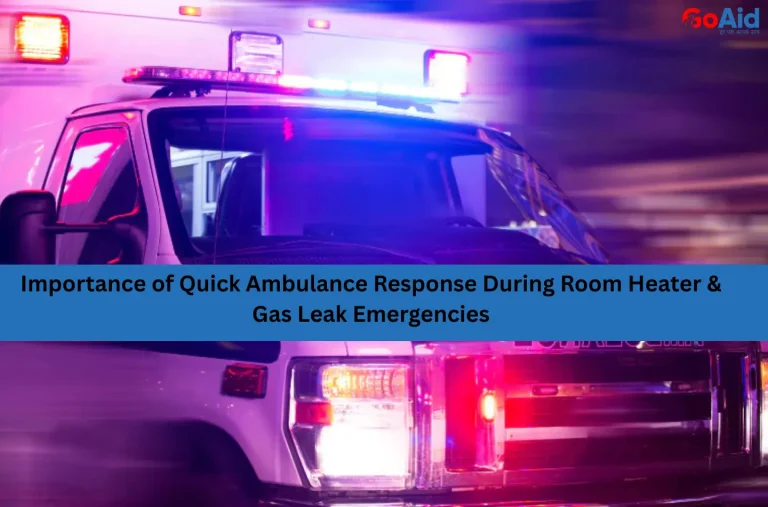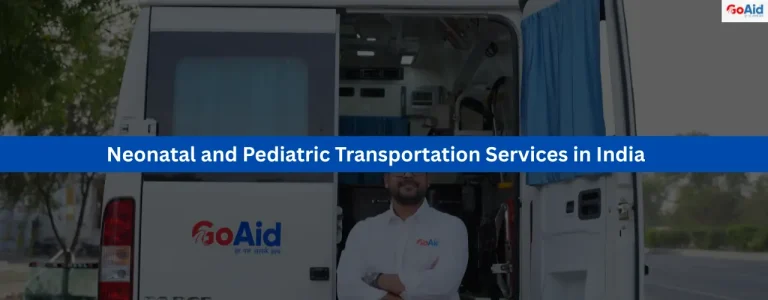In India, Shipping ports and marine industries face several risks due to harsh environmental conditions and heavy machinery. ThatŌĆÖs why ambulance services are crucial to provide immediate emergency care during medical emergencies. This also ensures timely care for workplace injuries and other health emergencies.
In this blog, we have provided you with important information about Why Ambulance Services Are Essential for the Shipping Ports & Marine Industries. Its current challenges and types of ambulance services, and how can GoAid be used as a Reliable Partner for Shipping Ports & Marine Industries? Are you excited to know about it? If yes, then why wait?
LetŌĆÖs start reading
Overview of the Shipping Ports & Marine Industries
Shipping ports and marine industries are vital hubs for global trade and infrastructure development, involving activities like cargo handling, ship maintenance, and offshore operations. These environments present significant risks, including workplace injuries and medical emergencies that require prompt attention.┬Ā
Ambulance services tailored for shipping ports and marine industries ensure quick emergency response, first aid availability, and safe patient transport. On-site ambulance presence in these sectors improves labor safety, reduces downtime, and supports compliance with safety regulations. Industrial ambulance services at construction zones and port facilities are essential to protect workers and maintain smooth operations in this high-risk industry.
Common Health & Safety Problems at Shipping Ports & Marine Industries
Shipping ports and marine industries face numerous health and safety challenges due to their complex operations and harsh environments. Addressing these issues with specialized ambulance services is essential for effective emergency response and workplace injury management.
- Heavy Machinery Accidents: Risk of injuries from cranes, forklifts, and other heavy equipment demands immediate ambulance response to provide critical emergency care.
- Slips, Trips & Falls: Wet surfaces and uneven docks increase fall incidents, requiring prompt first aid and transport by ambulance to prevent complications.
- Hazardous Material Exposure: Handling fuels and chemicals poses health risks, where on-site ambulance services ensure quick medical intervention in case of poisoning or burns.
- Drowning & Water-Related Incidents: Proximity to water creates drowning hazards, making rapid emergency response and rescue critical for survival and effective care.
- Confined Space Emergencies: Workers in tanks or cargo holds face suffocation or toxic exposure, necessitating specialized ambulance support for timely medical assistance.
- Heavy Physical Labor Injuries: Labor-intensive tasks can cause musculoskeletal injuries that need fast evaluation and treatment by ambulance teams for worker safety.
- Fire & Explosion Risks: Fuel storage and welding activities increase fire hazards, where industrial ambulance services provide urgent care and patient transport.
- Extreme Weather Conditions: Exposure to heat, cold, or storms leads to health emergencies, making on-site ambulance availability crucial for worker protection and quick response.
Why Ambulance Services Are Essential for the Shipping Ports & Marine Industries?
Ambulance services are critical in shipping ports and marine industries to ensure timely emergency care, reduce injury severity, and improve labor safety. Their presence supports quick medical response, minimizing downtime and saving lives in high-risk working conditions.
- Rapid Emergency Response: Ambulance services ensure immediate medical attention after accidents, reducing the time between injury and treatment. This quick response is vital in preventing complications and improving survival chances in shipping ports and the marine industries.
- On-Site Ambulance Service: Having ambulances stationed directly at ports and marine sites enables instant emergency care. This eliminates delays caused by transporting injured workers to distant hospitals, enhancing first aid effectiveness and patient outcomes.
- Specialized Medical Emergency Care: Ambulances equipped with advanced life support and trained paramedics can handle unique injuries typical in marine industries, such as drowning, chemical exposure, or heavy machinery accidents, ensuring precise and timely treatment.
- Compliance with Safety Regulations: On-site ambulance availability helps industries meet government safety standards and workplace regulations, reducing legal risks and fostering a culture of safety and responsibility in shipping ports and marine operations.
- Support for Infrastructure Projects: Ambulance services at port construction and infrastructure zones provide rapid care for construction-related injuries, preventing minor injuries from escalating and allowing projects to continue safely with minimal disruptions.
- 24/7 Availability: Emergencies can happen anytime, day or night. Round-the-clock ambulance service ensures continuous medical coverage, so injured workers receive prompt care regardless of shift timings or operational hours in marine industries.
- Improved Labor Safety and Confidence: Knowing that ambulance and emergency services are readily available reassures workers, encouraging safer practices and boosting morale, which contributes to a healthier, more productive workforce in shipping and marine sectors.
- Interstate Ambulance Coverage: Many shipping ports operate across multiple states. Ambulance services with interstate capabilities facilitate smooth patient transfers between hospitals or ports, ensuring continuous care without administrative or logistical delays.
Types of Ambulance Services Might be Required in the Shipping Ports & Marine Industries
Shipping ports and marine industries require diverse ambulance services to handle a wide range of emergencies. These specialized ambulances ensure appropriate care for different injury types and medical situations unique to this high-risk sector.
- Normal Ambulance: Provides basic emergency medical support and patient transport for minor injuries or health issues at shipping ports, ensuring quick and safe transfer to medical facilities when needed.
- BLS Ambulance (Basic Life Support): Equipped with essential life-saving equipment and staffed by trained paramedics, BLS ambulances provide first aid and basic emergency care on-site in marine industry emergencies.
- ALS Ambulance (Advanced Life Support): Offers advanced medical treatment with trained emergency physicians and paramedics, essential for critical injuries and severe health emergencies at ports and marine operations.
- ICU Ventilator Ambulance: Equipped with intensive care units and ventilators, these ambulances are vital for transporting critically ill or injured workers requiring continuous life support during transfer.
- Dead Body Mortuary Van: Provides dignified and safe transport of deceased individuals from shipping ports or marine facilities, ensuring compliance with legal and health regulations.
- Oxygen Ambulance: Supplies oxygen therapy for workers suffering from respiratory distress, chemical exposure, or other emergencies requiring immediate oxygen support at marine sites.
- Surgery Ambulance: Specialized for emergency surgeries or critical interventions that may be required during transportation of injured workers from ports to hospitals.
- Interstate Ambulance Service: Facilitates safe and regulated patient transfer between ports or medical centers across state borders, ensuring seamless emergency care continuity in marine industry operations.
Also Read: Difference between BLS Ambulance and ALS Ambulance
Current Challenges in Providing Ambulance Services to Shipping Ports & Marine Industries
Ambulance services in shipping ports and marine industries face unique challenges due to complex operations, remote locations, and hazardous environments. Overcoming these obstacles is crucial to ensure effective emergency response and labor safety.
- Access to Remote Areas: Many port and marine sites are located in hard-to-reach areas, making it difficult for ambulances to arrive quickly and provide timely emergency care to injured workers.
- Complex Infrastructure: Navigating large shipping yards, cranes, and container stacks can delay ambulance response time, impacting the delivery of critical medical services on-site.
- Harsh Environmental Conditions: Exposure to extreme weather, saltwater corrosion, and slippery surfaces poses risks to ambulance operations and paramedic safety during emergency interventions.
- Limited Medical Facilities On-Site: Shipping ports often lack advanced medical infrastructure, making ambulance services the primary source of emergency care, which places high demand on their readiness and equipment.
- Communication Barriers: Poor network connectivity or interference near marine sites can hamper coordination between ambulance teams and port authorities, delaying emergency response efforts.
- High Risk of Workplace Injuries: Frequent heavy machinery use and manual labor increase accident rates, requiring ambulance services to maintain constant readiness for diverse emergencies.
- Regulatory Compliance Challenges: Meeting various state and national regulations for ambulance services in marine industries demands strict adherence, which can complicate operations and increase costs.
- Interstate Coordination Difficulties: Ports spanning multiple states require seamless ambulance transfers across borders, but bureaucratic hurdles and differing protocols often cause delays in patient care.
How Can These Problems Be Solved?
In India, addressing challenges in ambulance services at shipping ports and marine industries requires strategic planning, technology adoption, and collaboration. Implementing these solutions ensures faster emergency response, better workplace safety, and effective medical care for workers in high-risk environments.
- Enhanced Infrastructure Access: Developing dedicated ambulance lanes and clear pathways within shipping ports improves access for emergency vehicles, enabling quicker response times to workplace injuries and medical emergencies.
- Advanced Navigation Systems: Using GPS and real-time tracking helps ambulances efficiently navigate complex port layouts, ensuring timely arrival at emergency scenes without unnecessary delays.
- Weather-Resilient Ambulances: Equipping ambulances with features to withstand harsh marine weather conditions protects paramedics and patients, ensuring uninterrupted emergency care regardless of environmental challenges.
- On-Site Medical Facilities: Establishing well-equipped first aid and medical stations at ports complements ambulance services by providing immediate care before patient transfer, enhancing overall emergency management.
- Improved Communication Networks: Implementing robust communication systems such as satellite phones and dedicated emergency channels ensures seamless coordination between ambulance teams and port authorities.
- Regular Safety Training: Conducting frequent training for port workers and ambulance staff on emergency protocols and first aid improves preparedness and reduces accident severity.
- Streamlined Regulatory Compliance: Collaborating with regulatory bodies to harmonize ambulance service standards across states simplifies operations and ensures legal compliance in marine industry emergency care.
- Interstate Ambulance Coordination: Creating unified protocols for ambulance transfers across state borders facilitates smooth patient handovers, minimizing treatment delays and ensuring continuous medical attention.
Future of Emergency Medical Services in Shipping Ports & Marine Industries
The future of emergency medical services in shipping ports and marine industries is poised for significant advancements driven by technology and stricter safety standards. Ambulance services will increasingly feature cutting-edge equipment such as advanced life support systems, real-time patient monitoring, and GPS tracking to enable rapid and precise emergency responses. This will greatly reduce injury severity and improve survival rates for workers in these high-risk environments.
On-site ambulance availability will become a fundamental requirement at all major ports, complemented by well-equipped first aid stations and highly trained paramedics ready to provide immediate care. Regulatory bodies are expected to enforce stricter mandates for ambulance services, ensuring better compliance and enhanced labor safety. Additionally, interstate ambulance services will be streamlined, allowing seamless patient transfers across different port locations.
Legal Obligation for Shipping Ports & Marine Industries
In India, ensuring worker welfare and meeting legal obligations are critical in shipping ports and the marine industries. On-site ambulance services are mandated by Indian laws to safeguard labor safety and demonstrate corporate social responsibility through timely emergency medical care.
- Compliance with the Motor Vehicles Act: This law requires all industrial sites, including shipping ports, to have access to ambulance services for immediate patient transport and emergency care.
- Factories Act 1948: Mandates first aid facilities and quick medical assistance on industrial premises, including marine industry workplaces, emphasizing ambulance availability for workplace injury ambulance needs.
- Employee State Insurance Act: Requires employers to provide medical benefits, including ambulance services, to insured workers, ensuring prompt emergency response in shipping ports and marine industries.
- Occupational Safety and Health Standards: Indian safety regulations encourage on-site ambulance presence to reduce medical emergency risks and promote worker health and safety.
- Corporate Social Responsibility (CSR): Shipping ports adopting ambulance services showcase responsibility toward labor welfare and community health, strengthening their social commitment.
- Legal Penalties for Non-Compliance: Absence of ambulance services can lead to fines and sanctions, compelling ports to maintain emergency response readiness.
- Labor Welfare Boards: Recommend or mandate ambulance availability to protect workers in hazardous marine and shipping environments.
- Continuous Monitoring and Reporting: Ports must regularly update authorities on ambulance readiness as part of safety audits, ensuring legal compliance and workplace safety.
How Can GoAid Be Used as a Reliable Partner for Shipping Ports & Marine Industries?
GoAid Ambulance Service offers comprehensive solutions tailored to the needs of shipping ports and marine industries, providing reliable emergency response and enhancing workplace safety through professional ambulance services and advanced medical care.
- 10-Minute Response Time: GoAid ensures ambulances reach shipping ports quickly, providing timely emergency care critical for labor safety and reducing injury severity.
- Diverse Ambulance Fleet: Offers Normal, BLS, ALS, ICU ventilator, and oxygen ambulances to handle all medical emergencies typical in the marine industry.
- 24/7 Availability: GoAid provides round-the-clock ambulance services, ensuring uninterrupted emergency response for shipping ports operating day and night.
- Government-Approved and Affordable: GoAid services comply with government regulations and offer cost-effective ambulance solutions suitable for large-scale port operations.
- Experienced Paramedics Team: Skilled paramedics provide professional medical assistance on-site, ensuring effective first aid and emergency care.
- Online and Mobile Booking: Easy ambulance booking through the GoAid app or phone enables quick dispatch during urgent medical emergencies.
- Interstate Ambulance Services: GoAid facilitates patient transfers across states, crucial for ports spanning multiple regions.
- Commitment to Excellence and Innovation: Continuous training and technology adoption make GoAid a trusted ambulance partner for shipping ports and marine industries.
Case Studies/Examples
Adani Group: Enhancing Emergency Response at Shipping Ports
Adani Group, a leader in port infrastructure, has implemented dedicated ambulance services at its shipping ports to improve medical emergency response. With on-site ambulance availability and a trained paramedic team, Adani ensures rapid workplace injury ambulance care. Their integration of advanced ambulance fleets, including BLS and ICU ventilator ambulances, highlights a commitment to labor safety and marine industry emergency care. This initiative reduces response times and supports regulatory compliance, setting a benchmark for ambulance services in IndiaŌĆÖs shipping and marine sectors.
Tata Steel: Comprehensive Ambulance Solutions for Marine Industry Safety
Tata SteelŌĆÖs marine operations have adopted GoAidŌĆÖs ambulance services to address medical emergencies efficiently. Their partnership provides 24/7 ambulance availability, diverse ambulance types, and quick response times crucial for shipping ports. The inclusion of on-site ambulance service and interstate ambulance transfers enhances worker welfare and industrial ambulance service standards. Tata SteelŌĆÖs focus on ambulance-based emergency care demonstrates how corporate social responsibility aligns with regulatory safety mandates in the marine industry.
Conclusion to the Need for Ambulance Services in Shipping Ports & Marine Industries
Ambulance services are vital for shipping ports and marine industries due to the high-risk nature of their operations. Immediate access to ambulance services ensures quick response to workplace injuries and medical emergencies, significantly improving labor safety and health outcomes. The availability of diverse ambulance types, such as BLS, ALS, and ICU ventilator ambulances, caters to the unique needs of marine industry emergencies.
Furthermore, legal regulations and corporate social responsibility underscore the necessity of on-site ambulance services at ports. Reliable emergency response systems not only protect workers but also help maintain operational efficiency and regulatory compliance. Investing in ambulance infrastructure is essential for safeguarding lives and supporting sustainable growth in shipping ports and marine industries.
Call-to-Action (CTA)
Ensure your shipping port or marine facility is equipped with reliable ambulance services today. Partner with GoAid for fast, affordable, and government-approved emergency medical care tailored to your industryŌĆÖs needs.
FAQs on the Need for Ambulance Services in Shipping Ports & Marine Industries
Question 1: Why are ambulances needed at construction sites?
Answer: Ambulances at construction sites provide immediate emergency care for workplace injuries, ensuring fast medical response, reducing severity, and improving worker safety in high-risk environments like shipping ports and marine industries.
Question 2: What types of injuries are common in the Shipping Ports & Marine Industries?
Answer: Common injuries include slips, falls, machinery accidents, chemical exposure, burns, fractures, and drowning risks, all requiring prompt ambulance response for effective emergency care and labor safety.
Question 3: Is it mandatory to have ambulance services at Shipping Ports & Marine Industries in India?
Answer: Yes, legal regulations mandate on-site ambulance services at shipping ports and marine industries to ensure workplace injury ambulance care and compliance with safety laws.
Question 4: Can private companies provide ambulance services to Shipping Ports & Marine Industries?
Answer: Yes, many private ambulance providers offer specialized, government-approved ambulance services for shipping ports, ensuring quick and professional emergency medical support.
Question 5: What should a Shipping Ports & Marine Industries company look for in an ambulance service provider?
Answer: Companies should seek providers with fast response times, diverse ambulance types, trained paramedics, 24/7 availability, government approvals, and experience in industrial ambulance service.
Question 6: What is an on-site ambulance service?
Answer: On-site ambulance service means ambulances are stationed within or near the port or marine industry site, ensuring rapid emergency response and immediate first aid for workplace injuries.
Question 7: How does an ambulance service improve worker safety in Shipping Ports & Marine Industries?
Answer: Ambulance services provide timely medical attention, reduce injury severity, support first aid, and ensure safe patient transport, significantly enhancing labor safety in marine and port operations.
Question 8: Can ambulance services be customized based on the size of the project?
Answer: Yes, ambulance services can be tailored with appropriate ambulance types, staffing levels, and equipment to match the scale and specific emergency care needs of shipping ports and marine industries.
Question 9: Are there any legal obligations for emergency medical support at Shipping Ports & Marine Industries?
Answer: Yes, Indian laws require on-site ambulance availability and adequate emergency medical support to protect worker welfare and comply with occupational safety standards in the marine industries.
Question 10: How much does it cost to hire an ambulance service for the Shipping Ports & Marine Industries?
Answer: Costs vary by ambulance type, service duration, and location, but government-approved providers offer affordable rates, ensuring cost-effective emergency response for shipping ports and marine industries.
Question 11: Do ambulance providers offer trained paramedics along with the vehicle?
Answer: Yes, reliable ambulance services include experienced paramedics trained in workplace injury ambulance care and emergency medical support tailored for the marine and port industries.
Question 12: Can ambulances be equipped with trauma kits for Shipping Ports & Marine Industries-related injuries?
Answer: Absolutely, ambulances servicing shipping ports are equipped with trauma kits, oxygen supplies, ventilators, and other essential emergency equipment for comprehensive medical care.
Question 13: How fast can an on-site ambulance respond compared to city emergency services?
Answer: On-site ambulances in shipping ports typically respond within 10 minutes, significantly faster than city emergency services, ensuring prompt treatment for workplace injuries.
Question 14: How does having an ambulance affect insurance and liability claims?
Answer: Having ambulance services reduces liability risks, ensures faster medical documentation, and often supports smoother insurance claims for workplace injury and emergency medical incidents.
Question 15: Is a 24/7 ambulance service necessary for Shipping Ports & Marine Industries?
Answer: Yes, since shipping ports operate continuously, 24/7 ambulance services ensure uninterrupted emergency response and protect worker safety during all shifts.
















